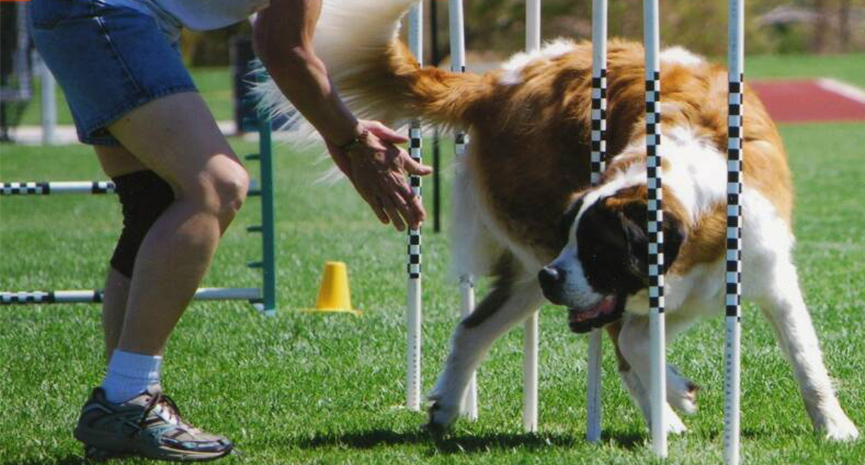After thousands of years of practice, you might think that training a dog would be a natural, almost intuitive, process for humans. But, too often, we make honest errors in training that result in strained relations. Owing to the dog’s resilient nature, minor mistakes rarely result in catastrophe. But major errors can cost owners (and dogs) years of frustration. Here are some of the biggest training miscues owners make, and alternatives to improve chances of keeping you and Fido on the straight and narrow.
Remember dog training is a lot like the beautiful martial art of Tai Chi, with equal parts physical and philosophical. It takes timing, technique, and stamina, as well as a devotion to understanding the canine mind. It is not a skill that can be learned by watching one half-hour television show or from reading a few books. It takes time.
When you simply react to Fido’s misbehaviors, you lose the opportunity to teach. Instead, practice your technique; anticipate his reactions ahead of time, becoming more proactive in the process. For example, if trying to quell a barking issue, instead of waiting for the barks to start, catch Fido right before his brain says “bark,” and distract it into some other, more acceptable, behavior. Know that whatever stimulus is causing the barking needs to be either eliminated or redefined as a “good thing” in the dog’s head. This takes experience and a proactive role on your part.
Loss of confidence is a weakness, and as natural predators, dogs can sense it instinctively. It’s why frightened people get bitten more often than calmer individuals. Show a lack of confidence and Fido will exploit it. That’s not a condemnation of your pet; it’s just a dog’s nature. To avoid this, simply work him more and attain some training successes. Attending a class with him can work wonders to increase your confidence.
Dogs need to feel that their mentors and providers are consistent in behavior and in rule setting. If you vary training technique too much, especially in the beginning, you’ll diminish your dog’s ability to learn. For instance, if one day you stay patient with a stubborn dog, but the next day lose your cool, it won’t be able to predict how you’ll react at any given moment. This breaks confidence and trust. Instead breaks confidence and trust. Instead, stick to a consistent methodology and be unswerving regarding what is suitable behavior. For instance, if Fluffy isn’t allowed on the bed, but you let it happen two times out of ten, that’s inconsistent. Set rules and stick to them.
Instead of “training then forgetting,” keep your dog’s established behaviors sharp by working them randomly. “Sit” for dinner, “wait” at doors, “down” at the dog park; be spontaneous and unpredictable. Every once in a while teach a new behavior, lie a trick to keep your dog’s mind and motivation up. The larger your pet’s repertoire of behaviors, the smarter he or she gets, and the more important you become.
Sometimes a owner has taught a behavior such as “sit,” but, due to distractions, bad technique, or confusion on the dog’s part, the pet fails to respond. The owner asks repeatedly until, after the sixth or seventh attempt, the dog halfheartedly sits. This stalling becomes a learned behavior, one that’s hard to break.
This often occurs with behaviors that haven’t been fully proofed, or with one the dog doesn’t particularly like to perform. Headstrong dogs, for instance, hate to lie down, as it is an admission of deference. Timid dogs also resist lying down, a position they might deem too unsafe.
Teach “sit,” as if it’s a fun trick; Use a treat reward at first, praise, then work it in other locations, reducing treat rewards along the way while increasing praise. Make sitting, lying down, or coming when called the greatest things to do.
Once you are sure a dog knows a behavior, ask only once! If you are ignored, it’s either because you haven’t taught it properly, or the dog is distracted or simply rebellious (yes, they can be!). Take Fido to a quiet spot and ask again; if he still doesn’t respond, go back to basics and re-teach, avoiding the mistake of asking multiple times, or of making the behavior seem dreary or unbeneficial. If you suspect your dog is simply blowing you off, don’t be afraid to show your disappointment by saying in a convincing tone: “No; sit.”
And after asking once without response, wait a moment, while looking your dog square in the eye and moving in a bit closer. Often this will be enough to get the dog to comply. Then praise!
Teaching new behaviors to a dog is a process of evolution, not revolution. The key is in knowing that it’s usually going to take numerous sessions to perfect a new behavior.
Time spent on a training session should reflect some positive result; as soon as you attain some obvious level of success, reward, then quit. Don’t carry on and on, as you’ll likely bore the dog, and actually condition it to become disinterested in the new behavior. Likewise, don’t end a session until some evidence of success is shown, even if it’s a moment of focus or an attempt by the dog to try to perform. Remember that ten one-minute sessions in a day trump one ten-minute session every time.
And excessive emotion can put the brakes on a dog’s ability to learn. Train with force, anger, or irritation and you’ll intimidate it and turn training sessions into inquisitions. Likewise, train with hyperbolic energy, piercing squeals of delight, and over-the-top displays of forced elation, and you will stoke a dog’s energy levels far beyond what is needed to focus and learn.
Adopt a sense of “calm indifference”-a demeanor suggesting competence, and a sense of easy authority. A laid-back, loving, mentoring kind of energy that calms a dog, and fills it with confidence. If your dog goofs up, instead of flying off the handle, back off, and try again. Likewise, if it gets something right, instead of erupting with shrill pomp, just calmly praise, smile, then move on. The dog will gradually imprint on this relaxed attitude and reflect it.
If you stick to these basic guidelines, you’ll slowly redefine yourself as the resident trainer, and not just your dog’s concierge. Practice, succeed, be confident, and have fun with your protege!





